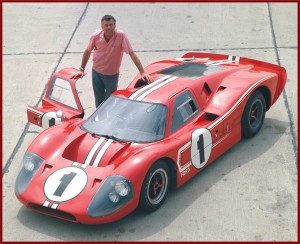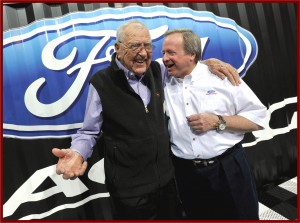
It was while he co-owned a Dallas dealership with fellow Texans Jim and Dick Hall that Shelby first started car manufacturing.
Carroll Hall Shelby, a legendary sports car racer and builder died Thursday at age 89, his company, Carroll Shelby International, said today. The creator of the Cobra, Shelby passed away yesterday at Baylor Hospital in Dallas. Carroll Shelby is the only man to have won the 24 Hours of Le Mans race as a driver, team owner and automotive manufacturer.
Shelby once told me that he “spent a ton of old man Ford’s money, and kicked Ferrari’s ass,” which his team did for successive years at the 24 Hours of Le Mans until a rule change made the brutally fast and reliable Ford GT cars illegal. He had many other racing successes as well.
As part of the Le Mans deal, Carroll took in Henry Ford II’s son, Edsel Ford II, under his supervision at the race shop during summers. Edsel confirmed the friendship years later, and in his own self-effacing way told me that he mostly swept the floors and enjoyed every minute of it.
“At Ford, Carroll Shelby will always be remembered as an innovator, a performance vehicle legend but most importantly an incredible partner and close friend for more than 60 years,” said Edsel Ford II today.
Born on 11 January 1923, in East Texas, Shelby was the son of a postal worker in Leesburg, Texas. Shelby attended high school in Dallas and joined the Army to fight in World War II. After serving as an aviator in the war, he returned home to Texas where he dabbled in business with a dump truck operation, a failed chicken farm and a sports car dealership.
It was while he co-owned the Dallas dealership with fellow Texans Jim and Dick Hall that Shelby first tasted car manufacturing. Together, they created a handful of “Scaglietti Corvettes” that were based on GM’s roadster.
Shelby’s first race was at a drag strip in a 1932 Ford. Moving on to road courses, he raced throughout the USA in his spare time. When all of his chickens died of limberneck disease, Shelby moved into the cockpit as a career.
Once on his way to a race, Shelby had to wear his work clothes from the farm to make the start time. When his odd racing attire netted him more attention and publicity than his victory, Shelby made the striped bib coveralls his trademark.
Shelby won three national sports car championships in the United States, earned a spot on the Aston-Martin team in Europe, won the 24 Hours of Le Mans and set land speed records at the Bonneville Salt Flats. Twice, he was named Sports Illustrated’s “Driver of the Year.”
When a heart condition caused Shelby to abandon driving prematurely in 1960, he went into car design. He first approached Chevrolet because of his experience with the Scaglietti Corvettes. The idea was to cram the 283-c.i.d. Chevrolet small block V8 into a British AC Ace chassis. GM turned down what would have essentially been a competitor to the existing Corvette sports car.
Legend has it that Shelby then approached Lido Anthony Iacocca at Ford Motor Company with the idea of building a two-seat sports car using the company’s new small block V8 engine. It was the beginning of a lifelong friendship between the two, and the beginning of the now legendary Cobra.
When Ford agreed to supply motors and money, Shelby formed “Shelby American” around a group of Southern California hot rodders. The resulting hybrid was dubbed the Cobra, a name that Carroll claimed came to him in a dream; Shelby’s CSX2000 was introduced at the New York Auto Show in 1962.
After developing a competition version of the Cobra, Shelby fielded a team in Europe to race against the Germans, British and Italians. In addition to racing the Cobras, both in coupe and roadster versions, he added Ford GT’s to the team at the request of Ford Motor Company.
In 1965, they won the FIA sports car world championship and the next year captured the overall win LeMans with the Ford GT and a class win in the Cobra Daytona Coupe.
“Carroll Shelby was an automotive visionary and leader,” said Dan Gurney, who was part of the Shelby American racing team and an American legend himself in the racing world. “His West Texas down-home bib overall style had a huge emotional impact on me and when he launched his now legendary Ford powered Cobra team, I found myself a very willing volunteer to lend my driving ability to his quest to take on the established European teams on their home turf.
“As part of Shelby American, we managed to win some tremendous races together: the very first FIA sanctioned points race for Cobra at Bridgehampton 1963 in a Cobra Roadster, the GT classes at the Targa Florio, at Le Mans and at Goodwood with the Daytona Cobra Coupe in 1964. Then we won the crown jewel: the 1967 Le Mans 24 Hour Race with the Ford Mark IV. His leadership was very unconventional and more powerful than either his friends or competitors ever imagined. His charm will be missed, his reputation as a motorsports icon is secure.”
At the same time, Shelby’s operations turned out the Shelby 289 and 427 Cobras, as well as a succession of Mustang-based Shelby’s created at the request of Lee Iacocca at Ford Motor Company. He scaled back his California operations in the late 1960s when new government regulations and insurance rules began to affect the sales of performance cars. For several years, he operated businesses in Africa until civil war in the region closed them down.
Shelby was also a pioneer for modern licensing programs in the automotive industry. Beginning in the 1960s, he began licensing his name and designs for various products. Unfortunately, he was forced to assert his right to his famous trademarks and designs many times over the years, too.
In 1982, he began helping his friend Iacocca, now head of Chrysler, to enhance performance of the cars at the Number Three U.S. automaker. His team arguably created the muscle truck and developed the Dodge Viper, which paced the 1991 Indy 500 with Shelby at the wheel.
In 1988, Shelby started building Cobras again. Teaming with McCluskey, Ltd, he began development of the “mystical 43” 427 S/C big block Cobras, which were the last 43 chassis numbers left from FIA homologation. That laid the groundwork to develop a limited line of “continuation” big block Cobras.
In 1995, his long-established company, Shelby American, opened a facility in Las Vegas at the new Speedway to expand his continuation Cobra operations. In Las Vegas, he later manufactured the Oldsmobile powered Series 1 roadster in cooperation with GM and added other Cobra models. In 2005, Shelby entered into a new agreement with Ford Motor Company that involved him in the development of the new Ford GT and led to the re-introduction of several Mustang based Shelby cars, including the Shelby GT-H, Shelby GT-500, Shelby GT-500 “Super Snake,” Shelby GT and Shelby GT500KR.


